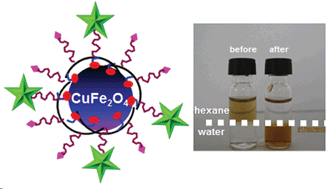Synthesis, characterization and functionalization of nearly mono-disperse copper ferrite CuxFe3−xO4 nanoparticles†
Abstract
Magnetic

* Corresponding authors
a
Institut für Anorganische Chemie und Analytische Chemie, Johannes Gutenberg-Universität, Duesbergweg 10-14, Mainz, Germany
E-mail:
tremel@uni-mainz.de
Fax: +49 6131 39-25605
Tel: +49 6131 39-25135
b Institut für Physikalische Chemie, Johannes Gutenberg-Universität, Welderweg 11, Mainz, Germany
c Bereich Medizinische Physik, Klinik und Poliklinik für diagnostische und interventionelle Radiologie, Klinikum der Johannes Gutenberg-Universi-tät Mainz, Langenbeckstraße, 1, Mainz, Germany
Magnetic

 Please wait while we load your content...
Something went wrong. Try again?
Please wait while we load your content...
Something went wrong. Try again?
B. Nakhjavan, M. N. Tahir, M. Panthöfer, H. Gao, T. D. Schladt, T. Gasi, V. Ksenofontov, R. Branscheid, S. Weber, U. Kolb, L. M. Schreiber and W. Tremel, J. Mater. Chem., 2011, 21, 6909 DOI: 10.1039/C0JM04577B
To request permission to reproduce material from this article, please go to the Copyright Clearance Center request page.
If you are an author contributing to an RSC publication, you do not need to request permission provided correct acknowledgement is given.
If you are the author of this article, you do not need to request permission to reproduce figures and diagrams provided correct acknowledgement is given. If you want to reproduce the whole article in a third-party publication (excluding your thesis/dissertation for which permission is not required) please go to the Copyright Clearance Center request page.
Read more about how to correctly acknowledge RSC content.
 Fetching data from CrossRef.
Fetching data from CrossRef.
This may take some time to load.
Loading related content
